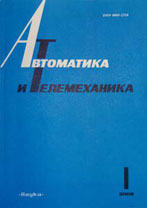|
This article is cited in 5 scientific papers (total in 5 papers)
Optimization, System Analysis, and Operations Research
Applying an approximation of the Anderson discriminant function and support vector machines for solving some classification tasks
V. V. Zenkov
Trapeznikov Institute of Control Sciences, Russian Academy of Sciences, Moscow, Russia
Abstract:
The Anderson discriminant function has a number of properties useful for solving classification problems and for evaluating posterior class probabilities. As the mathematical formalism, we use the same weighted least-squares method to approximate the Anderson discriminant function in the neighborhood of zero values both in solving the classification problem and in evaluating posterior probabilities of classes at a given point in the feature space. In the support vector method, the classification problem is solved by solving a quadratic programming problem with the number of constraints equal to the number of rows in the training sample, and to evaluate posterior probabilities of the classes an additional tool is used, namely the Platt calibrator, which converts the distance of the point to the boundary to the posterior probability of the class; the calibrator’s parameters are found with the maximum likelihood method. Using several examples of solving classification problems, we compare the performance of the methods by the criterion of empirical risk. The results are in favor of the method of approximating the Anderson discriminant function in the neighborhood of zero values.
Keywords:
machine learning, classification, Anderson discriminant function, support vector
machines, SVM, approximation of the Anderson discriminant function in the neighborhood of
zero values.
Citation:
V. V. Zenkov, “Applying an approximation of the Anderson discriminant function and support vector machines for solving some classification tasks”, Avtomat. i Telemekh., 2020, no. 1, 147–160; Autom. Remote Control, 81:1 (2020), 118–129
Linking options:
https://www.mathnet.ru/eng/at15268 https://www.mathnet.ru/eng/at/y2020/i1/p147
|

| Statistics & downloads: |
| Abstract page: | 239 | | Full-text PDF : | 49 | | References: | 32 | | First page: | 9 |
|




 Contact us:
Contact us: Terms of Use
Terms of Use
 Registration to the website
Registration to the website Logotypes
Logotypes








 Citation in format
Citation in format 
